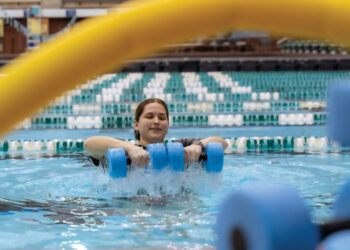From zip-lines to climbing walls to spa and saunas, the trends that make your aquatic center stand out are always evolving. It can be hard to keep track of the current trends in aquatic design, let alone look forward to the future. What do your students want now and what will they want three years from now? And more importantly, how can you provide this to them while using the least amount of resources.
To help, Jack Patton, a principle at RDG Planning and Design, answers a few of our questions about trends in aquatic design.
What are some of the trends you are currently seeing?
JP: I think there is a trend toward more hybrid water — water that is more multipurpose, that has an opportunity to serve a totally different user group during three or four hours of the day. It can transition from hour to hour, from one group to another. That affects the layout of the space, the amenities in the pool and the aquatic environment itself. Then as we look at the water basin itself, I think a press toward a facility that is both aesthetically pleasing, but also highly functional, so when it is not being using for active sports it has the ability to be used for a great reception for any of the groups on campus in a social or semi-social environment.
What are some ways aquatic centers can become more sustainable?
JP: In the natatorium there are multiple ways to do so. We can bring natural light into the aquatic center in a variety of ways that can often eliminate the need for synthetic lighting to be on during the day. At the University of Oregon, we have a large indoor light umbrella that is specifically designed to shed light that comes in the skylight and distribute it inside the space. It is really a phenomenal concept. Secondly, is realizing there is a lot of energy consumed in the natatorium. So re-using the heat energy that would have been wasted and transferring it to heat other portions of the building or to heat hot water for showers. We heat natatoriums to 85-88 degrees sometimes, once that air is no longer good to breath, it is still hot. We can use the heat from that air for other things throughout the building as a load management approach.
Looking toward the future, what trends do you see moving forward?
JP: More diverse active portions of water — additional growth of vortex areas, jump platforms, integrated climbing walls, multiple depth configurations, lounging spaces in water, creating more spa-like zones in the body of water itself, etc. We would describe what is happening as creating hybrid pools. They are good for competitive distance swimming, but they are also good for recreation swimming because of the temperature configurations and the amenities around it. Then I think we will see increased amenities. Things that support the space. For example, at North Dakota State University in the aquatic center that opened up a few months ago, we put an indoor fireplace in the pool area. It doesn’t really heat anything, but now the most popular time of day is the 10pm to Midnight swim because the fireplace is on, the lights are low and socialization opportunities make that a key time for everyone to hang in the pool. The fireplace is not the driver, but it is another piece that makes the space more fun.










